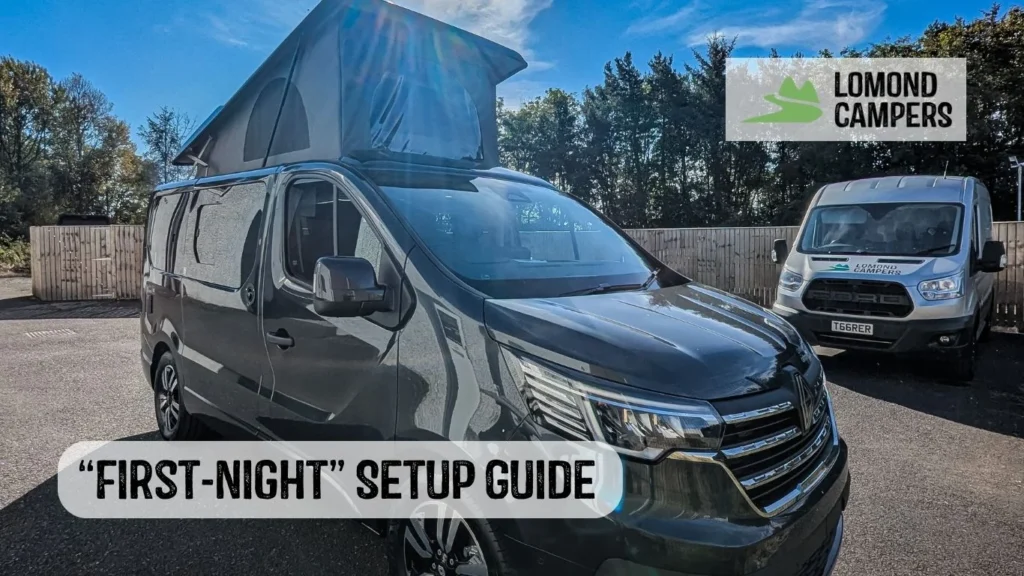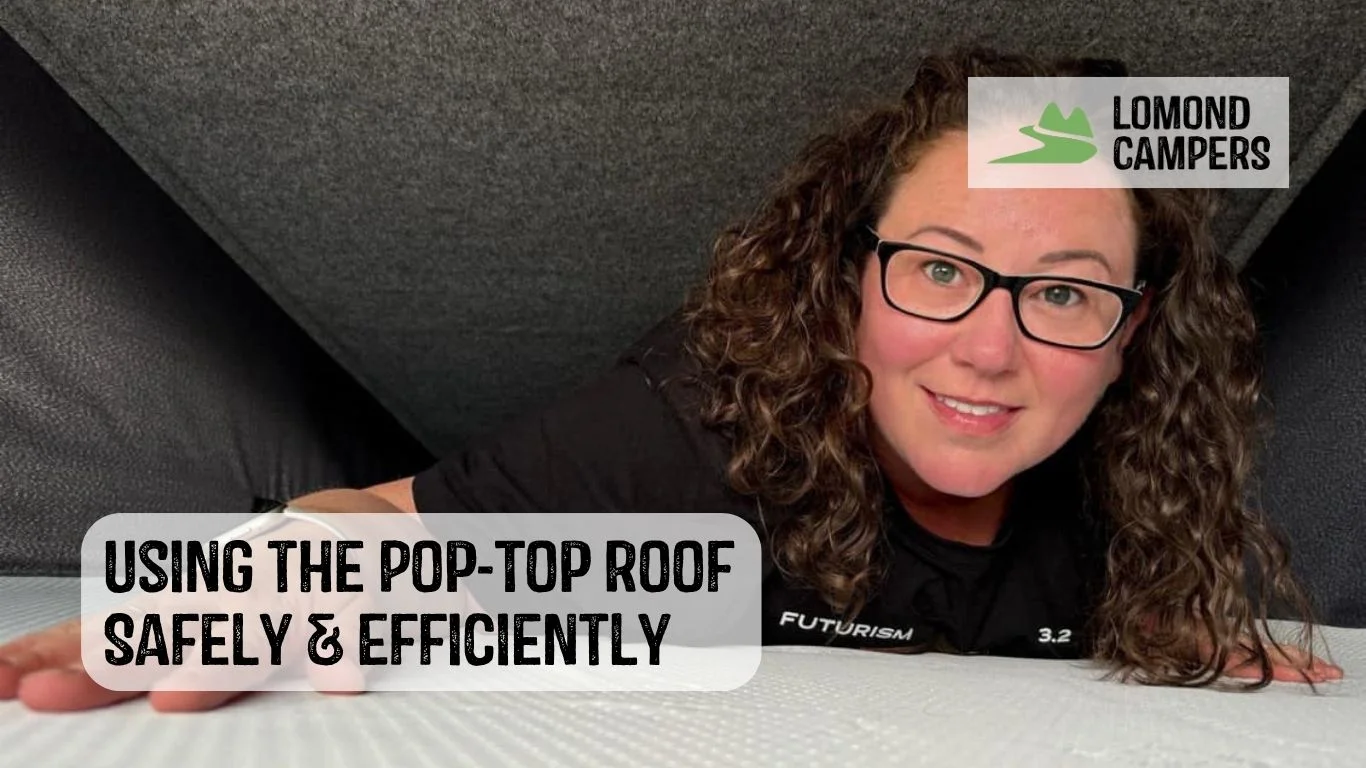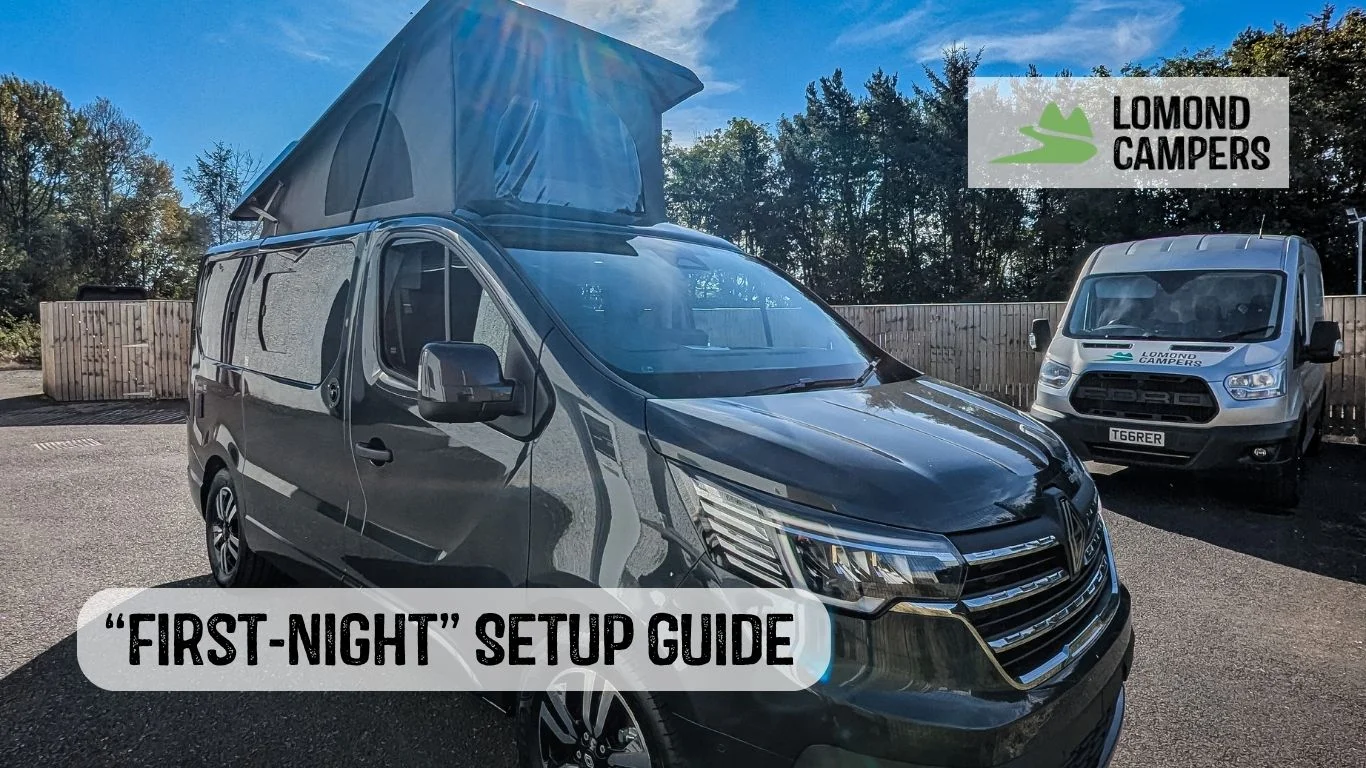Goal: arrive, get level, get services connected, and settle in—safely.
Quick-Start (2-minute overview)
- Park & position with the site EHU bollard on the driver’s side.
- Level the van (ramps under front wheels first) for a comfy sleep and a happy fridge.
- Hook up power: bollard OFF → plug into van → plug into bollard → bollard ON → switch your charger on (EC155 in rear wardrobe on most builds).
- Add fresh water and prime the taps.
- Open gas at the cylinder/tank, light the hob first to purge air, then use other appliances.
- Roof/bed if fitted: ignition OFF, clear fabric, lift evenly.
- Night checks: a crack of ventilation, gentle heat, CO alarm working, don’t block fixed vents.
1) Before You Set Off (Home Checklist)
Essentials to check
- Gas: cylinder/tank has fuel; valve closed for travel.
Why: prevents leaks while driving. - Fresh water: partly filled (about 10 L is plenty to start).
Why: avoids running the pump dry but doesn’t add too much weight/fuel use. - Toilet cassette: empty.
Why: nicer journey and less to do on arrival. - Batteries: leisure battery >70% if possible.
Why: you’ve got power if EHU is busy or down. - Kit packed: EHU cable (orange 230 V), levelling ramps & chocks, food-grade water hose (or container + funnel).
- Safety kit: tested CO alarm, fire extinguisher, first-aid kit, torch/headlamp.
- Documents: insurance, breakdown cover details.
2) On Arrival: Positioning & Levelling
Positioning
- Park so the EHU bollard is on the driver’s side (most sockets are there on our vans).
Why: shorter, neater cable run and less trip risk.
Levelling (do this before anything else)
- Place ramps under the front wheels first.
- Drive up slowly; stop when level.
- Handbrake on, engine off, then chock.
- For side-to-side tweaks, move the ramps as needed.
- Use a bubble level or levelling app.
Why: a level van sleeps better, doors slide properly, and the fridge cools correctly.
3) Electrical Hook-Up (EHU) — Safe Sequence
Site limits: UK bollards are commonly 10 A or 16 A (roughly 2.3–3.7 kW). A kettle + heater + microwave together may trip the supply. Stagger big appliances.
- At the bollard, make sure the breaker is OFF.
Why: prevents arcing when you connect. - Plug the EHU cable into the van first.
Why: your van inlet is safely recessed; reduces exposed live risk later. - Plug into the bollard.
- Switch the bollard breaker ON.
- Inside the van, turn the charger ON (with our standard EC155, switch is in the rear wardrobe).
Why: charges your leisure battery and powers 12 V systems cleanly.
If it trips:
- Turn off high-draw items (kettle/heater/microwave).
- Reset the bollard breaker, then your van’s RCD/MCBs if fitted.
- Reintroduce appliances one at a time.
4) Fresh Water & Waste (Grey)
Fresh water: fill & prime
- Fill the tank using a food-grade hose or container + funnel.
Why: food-grade avoids taste/odour and bacterial growth. - Switch the pump ON.
- Open each tap (hot then cold) until water flows smoothly without spluttering.
Why: this purges air so your pump runs quietly and the water system is steady.
Grey water (sink/shower waste)
- If the site requires it, place a waste container under the grey outlet, or ensure your onboard tank valve is shut until you reach the disposal point.
Why: some pitches don’t allow grey to spill; it keeps the pitch clean.
5) Gas & Appliances
Turn gas on
- Open the cylinder/tank valve (and ensure your 30 mbar regulator is on).
Why: correct pressure ensures safe, efficient appliance operation.
Purge air & get going
- Light the hob first and let it burn steadily for a moment.
Why: it’s the quickest way to purge air from the lines. - Then use your fridge (on gas, if needed) and heater as required.
Good practice: Any modifications or fault-finding on gas systems should be done by a competent LPG engineer. Safety first.
6) Pop-Top / Roof Bed (if fitted)
Before lifting
- Ignition OFF.
- Ensure doors, blinds, and fabric are clear so nothing snags.
Lift
- Unlatch evenly and push straight up with smooth, even pressure.
- For bed boards, lift/slide as per your model (we’ll have shown you at handover—ask us anytime for a refresher).
Lowering (later)
- Check the canvas is folding inward and not pinched in the scissor mechanisms.
- Latch both sides fully.
Why: Even, careful movement protects hinges, fabric, and seals—and avoids water ingress.
7) Fridge & Heating (quick notes)
- Fridge likes a level van. Give it time to cool after you arrive.
- Choose the right energy source (12 V while driving if fitted, 230 V on EHU, gas off-grid).
- Heating: start low and let it stabilise; boost in small steps.
Why: avoids tripping supply and prevents short cycling.
8) Night-Time Checklist
- Ventilation: crack a roof vent or window slightly.
Why: reduces condensation and keeps air fresh. - Heating: set to around 16–18 °C.
Why: comfortable without wasting energy. - CO alarm: test button; make sure it’s active.
- Never block fixed vents.
Why: they’re there for safe combustion and air quality. - Cables tidy, doors locked, blinds set.
9) Morning Departure (quick reset)
- Charger OFF (if you prefer), then bollard breaker OFF.
- Unplug bollard, then unplug at the van; stow the cable cleanly.
- Close gas valve for travel.
- Empty grey (and toilet cassette) at the site facility.
- Lower pop-top carefully; secure latches.
- Remove chocks, reverse off ramps slowly, stow them.
- Final walk-round check (locker doors, steps, skylights).
10) Common Issues & Quick Fixes
- No power on EHU:
- Check bollard breaker is ON.
- Check your van’s RCD/MCBs; reset if tripped.
- Reduce high-draw items (kettle/heater/microwave together can exceed site amps).
- Pump runs but no water:
- Ensure you filled the tank.
- Prime taps (open hot then cold until smooth flow).
- Check for any isolation valves left closed after winterising.
- Gas appliance won’t light:
- Confirm gas valve open.
- Light hob first to purge air, then try again.
- Wind can affect external flues—try a wind-sheltered orientation.
- Fridge warm:
- Confirm the van is level.
- Give it time after switching energy source.
- Avoid frequent door opening when first cooling.
11) Good Habits (why they matter)
- Level first: comfort + fridge efficiency.
- Correct EHU sequence: reduces arcing and nuisance trips.
- Hob purge first: quickest way to get gas flowing safely to all appliances.
- Ventilation at night: prevents condensation and keeps the air healthy.
- Close gas for travel: best-practice safety in motion.
12) Need Help?
If anything feels unclear at a site, don’t struggle—we’re happy to help.
- Email: info@lomondcampers.co.uk
- Book an appointment: lomondcampers.co.uk



